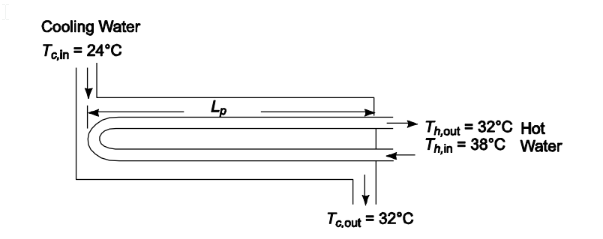What two things are needed to create an emission nebula?
A) interstellar gas and dust
B) hydrogen gas and carbon dust
C) hydrogen fusion and helium ionization
D) hot stars and interstellar gas, particularly hydrogen
E) cool stars and much interstellar dust
D
You might also like to view...
A shell-and-tube heat exchanger is to be used to cool 25.2 kg/s of water from 38°C to 32°C. The exchanger has one shell-side pass and two tube side passes. The hot water flows through the tubes and the cooling water flows through the shell. The cooling water enters at 24°C and leaves at 32°C. The shell-side (outside) heat transfer coefficient is estimated to be 5678W/(m 2 K). Design specifications require that the pressure drop through the tubes be as close to 13.8 kPa as possible and that the tubes be 18 BWG copper tubing (1.24 mm wall thickness), and each pass is 4.9 m long. Assume that the pressure losses at the inlet and outlet are equal to one and one half of a velocity heat (?V2/gc), respectively. For these specifications, what tube diameter and how many tubes are needed?
GIVEN
A water-to-water shell-and-tube exchanger, hot water in tubes, cooling water in shell One shell and two tube passes Hot water flow rate m
h= 25.2 kg/s Water temperatures
? Hot: Th,in = 38°C Th,out = 32°C
? Cold: Tc,in = 24°C Tc,out = 32°C Shell-side transfer coefficient h o= 5678 W/(m2 K) Pressure drop (?p) = 13.8 kPa Tube wall thickness (t) = 1.24 mm = 0.00124 m Tube length per pass (Lp) = 4.9 m
FIND
The tube diameter (Do) and number of tubes (N)
ASSUMPTIONS
Pressure losses at inlet and outlet (?pii) = 1.5 (? V2/gc) Variation of thermal properties with temperature is negligible Fouling resistance is negligible Thermal resistance of the tube walls is negligible
SKETCH

PROPERTIES AND CONSTANTS
for water at 30°C Density (?) = 995.7 kg/m3
Specific heat (cp) = 4176 J/(kg K)
Thermal conductivity (k) = 0.615 W/(m K)
Kinematic viscosity (?) = 0.805 × 10–6 m2/s
Prandtl number (Pr) = 5.4
An 80-km/h airplane caught in a 60-km/h crosswind has a resultant speed of
A) 60 km/h. B) 80 km/h. C) 100 km/h. D) 141 km/h.
A(n) ____________________ supernova is caused by the collapse of a massive star that has lost its outer envelope of hydrogen
Fill in the blank(s) with correct word
The maximum number of electrons allowed in the n = 1 shell of sodium is
A. 2. B. 6. C. 8. D. 4. E. unlimited.